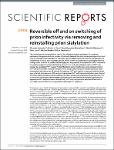Reversible off and on switching of prion infectivity via removing and reinstalling prion sialylation
Katorcha, Elizaveta
Daus, Martin L.
Gonzalez-Montalban, Nuria
Makarava, Natallia
Lasch, Peter
Beekes, Michael
Baskakov, Ilia V.
The innate immune system provides the first line of defense against pathogens. To recognize pathogens, this system detects a number of molecular features that discriminate pathogens from host cells, including terminal sialylation of cell surface glycans. Mammalian cell surfaces, but generally not microbial cell surfaces, have sialylated glycans. Prions or PrPSc are proteinaceous pathogens that lack coding nucleic acids but do possess sialylated glycans. We proposed that sialylation of PrPSc is essential for evading innate immunity and infecting a host. In this study, the sialylation status of PrPSc was reduced by replicating PrPSc in serial Protein Misfolding Cyclic Amplification using sialidase-treated PrPC substrate and then restored to original levels by replication using non-treated substrate. Upon intracerebral administration, all animals that received PrPSc with original or restored sialylation levels were infected, whereas none of the animals that received PrPSc with reduced sialylation were infected. Moreover, brains and spleens of animals from the latter group were completely cleared of prions. The current work established that the ability of prions to infect the host via intracerebral administration depends on PrPSc sialylation status. Remarkably, PrPSc infectivity could be switched off and on in a reversible manner by first removing and then restoring PrPSc sialylation.
Dateien zu dieser Publikation
Keine Lizenzangabe

